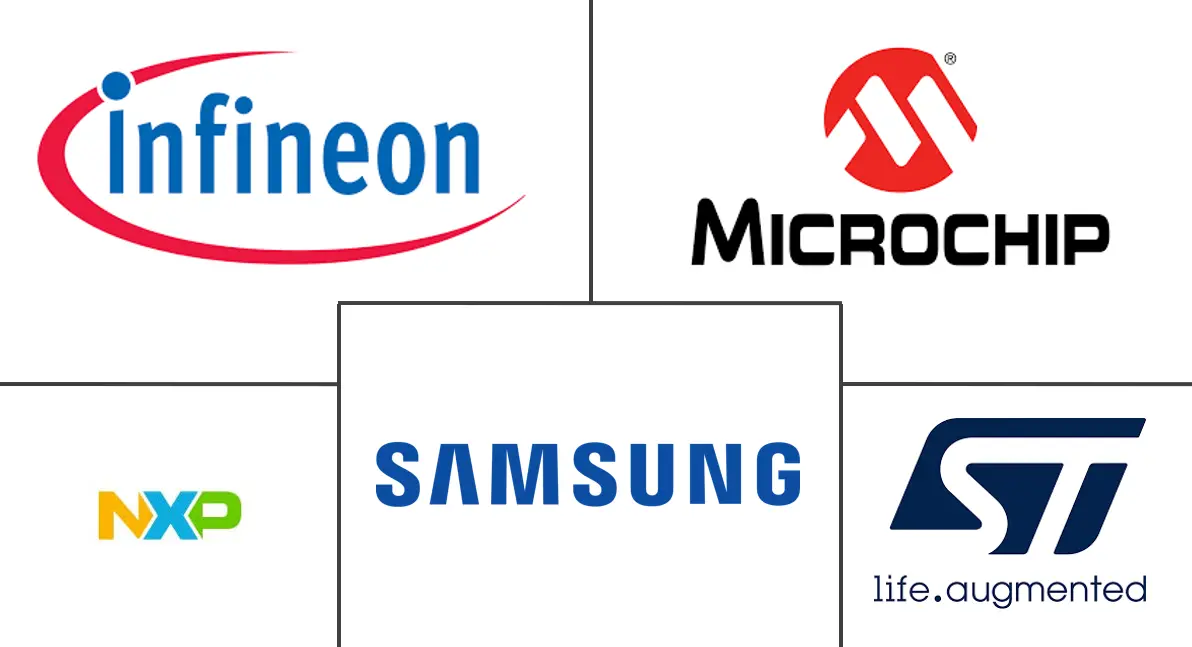Embedded Security Market Size and Share
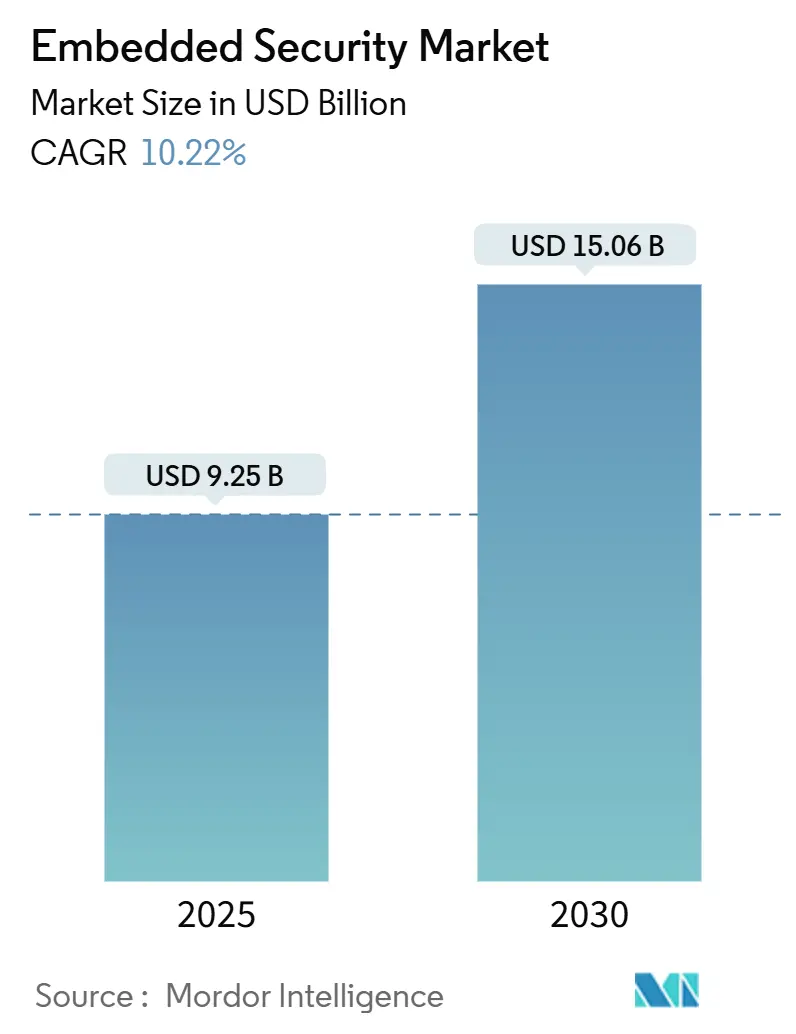
Embedded Security Market Analysis by Mordor Intelligence
The embedded security market is valued at USD 9.25 billion in 2025 and is forecast to reach USD 15.06 billion by 2030, reflecting a 10.22% CAGR. Demand is being propelled by the rapid spread of IoT edge devices, rising automotive cybersecurity mandates, and stricter regulations that require security-by-design across every connected product. Hardware-rooted trust elements now ship inside an expanding range of consumer electronics, industrial controllers, and vehicle ECUs, while post-quantum cryptography capability is moving from pilot projects to mainstream roadmaps. Semiconductor vendors are pairing secure elements with on-device AI threat analytics to block attacks in real time, and service providers are filling skill gaps through managed offerings that guide customers through complex migration, certification, and lifecycle management challenges. Competitive differentiation increasingly comes from power-efficient architectures that fit within tight size, weight, and cost envelopes, enabling security even in ultra-low-power sensors.
Key Report Takeaways
- By component type, hardware captured 69.2% of the embedded security market share in 2024, whereas services are projected to expand at a 14.2% CAGR through 2030.
- By application, authentication secured 36.7% of the embedded security market share in 2024, while content protection is expected to grow at a 15.7% CAGR to 2030.
- By end-user industry, consumer electronics held 29.2% of the embedded security market share in 2024; the automotive segment is advancing at a 16.2% CAGR during 2025-2030.
- By deployment type, cloud captured 57% of the embedded security market share in 2024 and is set to grow at a robust 13.22% CAGR through 2030.
- By geography, Asia Pacific led with 37.8% revenue share in 2024, whereas South America is on track for a 13.3% CAGR between 2025 and 2030.
Global Embedded Security Market Trends and Insights
Drivers Impact Analysis
| Driver | (~) % Impact on CAGR Forecast | Geographic Relevance | Impact Timeline |
|---|---|---|---|
| Proliferation of IoT edge nodes | +3.1% | Asia Pacific, North America | Medium term (2-4 years) |
| EMVCo contactless-payment mandates | +2.6% | Europe, North America | Short term (≤ 2 years) |
| Electrification/ADAS and high-integrity ECUs | +2.9% | Europe, North America, China | Medium term (2-4 years) |
| FOTA liabilities post-UN R155 | +2.2% | Europe, Japan | Short term (≤ 2 years) |
| Post-quantum crypto migration | +1.8% | North America, Europe | Long term (≥ 4 years) |
| Integration of hardware-based Root of Trust (RoT) | +2.4% | North America, Europe, Asia Pacific | Medium term (2-4 years) |
| Source: Mordor Intelligence | |||
Proliferation of IoT edge nodes in smart-home and industrial sectors
Billions of resource-constrained sensors now link factories, offices, and homes, forcing suppliers to embed tamper-resistant key storage and low-power cryptographic engines at the chip level. Secure elements such as Infineon’s OPTIGA Trust E provide hardened key vaults that draw micro-amp currents, allowing even coin-cell devices to run secure boot and encrypted messaging.[1]Infineon Technologies AG, “Company Presentation,” infineon.com AI-based anomaly detection is increasingly executed on those same chips, enabling real-time response without cloud latency and reducing bandwidth costs. The growth of private 5G and Wi-Fi 7 further enlarges the attack surface, making hardware-rooted trust mandatory for device onboarding. Consequently, the embedded security market is evolving from selective deployment toward universal inclusion inside edge silicon.
EMVCo’s contactless-payment mandates for cards and POS
New rules require cards and terminals to support stronger mutual authentication, dynamic data, and transaction-level cryptography, all within tight power budgets. Upgrades to legacy POS fleets dominate near-term spending, while issuers redesign smart cards around next-generation secure elements that can run sophisticated relay-attack countermeasures. The retrofit wave is widening the embedded security market beyond traditional banking into retail and hospitality, where merchants face penalties for non-compliance. Chipmakers are responding with ultra-thin secure controllers capable of field updates, extending product lifecycles, and reducing e-waste.
Rapid electrification and ADAS driving high-integrity automotive ECUs
Modern vehicles host more than 100 interconnected ECUs communicating over Ethernet, CAN-FD, and LIN. NXP’s Secure Vehicle Architecture illustrates the multi-layer defenses now required, integrating secure boot, hardware firewalls, and intrusion detection across zonal gateways.[2]NXP Semiconductors, “Secure Vehicle Architecture,” nxp.com Safety-critical nature raises the bar: failures threaten human life, so authentication, encrypted diagnostics, and tamper monitoring must coexist with real-time performance. As a result, content per vehicle for embedded security doubles across infotainment, battery management, and autonomous compute domains, enlarging the embedded security market throughout the supply chain.
Firmware-over-the-air (FOTA) update liabilities post-UN R155
UN R155 mandates verifiable and traceable software updates across entire vehicle fleets. Automakers now deploy cryptographic key orchestration and hash-accelerated signature engines directly on gateway SoCs to validate firmware blocks before installation. Research shows that SHAKE hash computation is the primary bottleneck; hardware accelerators are therefore bundled into next-gen automotive secure elements.[3]ScienceDirect, “On Hardware Acceleration of Quantum-Resistant FOTA,” sciencedirect.com These requirements elevate embedded security market demand among Tier-1 suppliers seeking turnkey key management and compliance services.
Restraints Impact Analysis
| Restraint | (~) % Impact on CAGR Forecast | Geographic Relevance | Impact Timeline |
|---|---|---|---|
| High ASP gap vs. discrete MCUs | -1.5% | Emerging markets | Medium term (2-4 years) |
| Fragmented standards across verticals | -1.2% | Global | Short term (≤ 2 years) |
| Supply-chain “ghost foundry” risks | -1.0% | Asia Pacific | Medium term (2-4 years) |
| Skill-set shortage in firmware verification | -0.8% | Global | Short term (≤ 2 years) |
| Source: Mordor Intelligence | |||
High ASP gap versus discrete MCUs in cost-sensitive IoT
Secure microcontrollers often carry 30-50% price premiums, creating difficult trade-offs for high-volume consumer and industrial sensor projects. Vendors now offer tiered SKUs, such as OPTIGA Trust M, that strip non-essential features to narrow the gap, yet buyers in emerging economies still hesitate. Until wafer yields climb and secure logic is integrated into base MCU lines, this cost differential will limit the addressable embedded security market in ultra-price-sensitive tiers.
Fragmented standards across verticals
GlobalPlatform specifications dominate payments, while Trusted Computing Group frameworks guide enterprise and industrial systems, forcing multi-market device makers to pursue parallel certifications. This fragmentation increases NRE costs and complicates secure supply chains, slowing time-to-revenue. Ongoing harmonization dialogues have yet to converge, leaving manufacturers to shoulder dual compliance paths in the interim.
Segment Analysis
By Component Type: Hardware foundations cement leadership as services surge
Hardware elements represented 69.2% of 2024 revenue, confirming their role as the anchor of trust chains that span bootloaders to the cloud. Secure elements, hardware security modules, and trusted execution environments isolate keys from application processors, blocking fault-injection and side-channel attacks even if host firmware is breached. Accelerated rollouts in payment cards, utility meters, and driver-monitoring cameras continue to enlarge the overall embedded security market volume. Meanwhile, the services ecosystem is scaling: audits, penetration testing, PKI hosting, and managed key rotation collectively advance at a 14.2% CAGR, reflecting customer reliance on external expertise for post-quantum transitions and 24/7 compliance monitoring.
The shift toward subscription models helps OEMs spread costs over device lifecycles, bolstering predictable revenue streams for vendors. Material inflation in advanced nodes has already nudged buyers to seek maximal ROI from every secure chip, driving adoption of add-on services such as certificate management and firmware scanning. This trend enlarges the embedded security market size for professional and managed services, bringing new entrants from traditional IT security into the edge device arena.
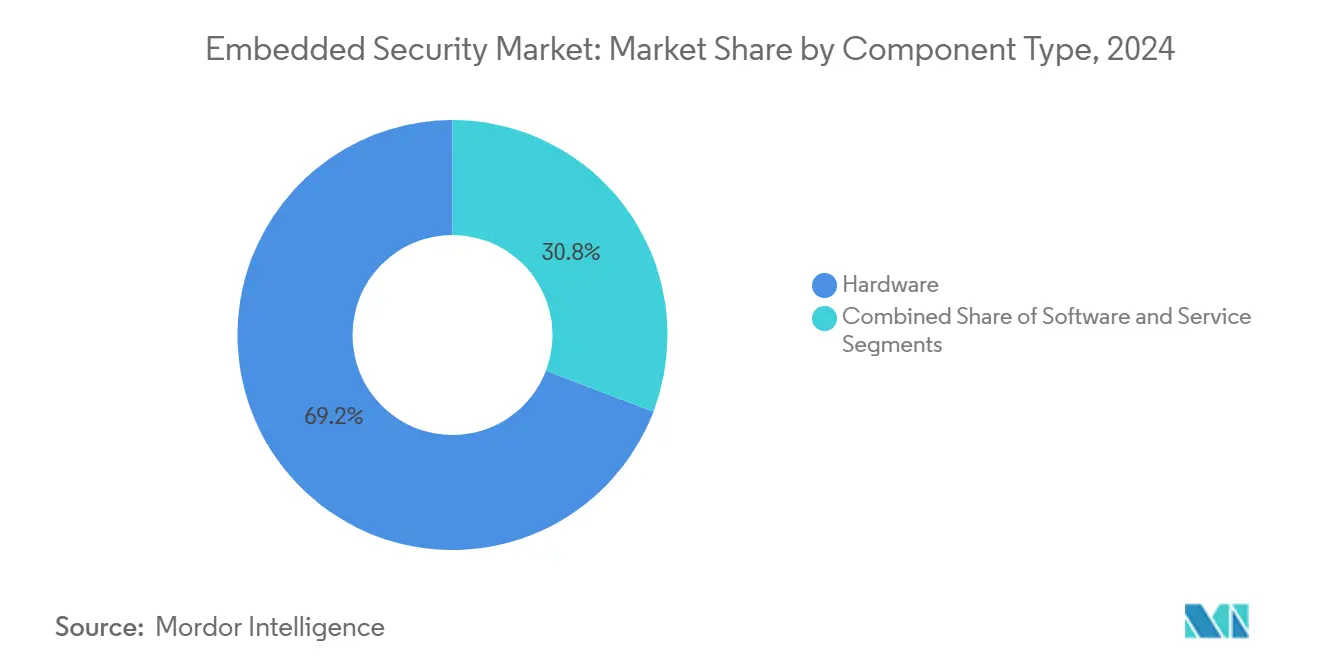
Note: Segment shares of all individual segments available upon report purchase
By Application: Authentication anchors growth while content protection accelerates
Authentication held a 36.7% share during 2024, underpinned by pervasive use of mutual-authentication protocols in industrial gateways, medical devices, and connected cards. Biometric enhancements - from fingerprint sensors in access badges to facial recognition inside vehicle cabins -strengthen multi-factor schemes and deepen silicon content per endpoint. Streaming, gaming, and collaborative design tools are driving the fastest expansion in content protection, forecast at 15.7% CAGR, as rights owners demand on-chip decryption, watermarking, and anti-rollback safeguards.
Piracy losses, heightened by 8K content and cloud gaming, make hardware-rooted digital rights management indispensable. Hybrid architectures blend secure decoders with cloud license servers, adding depth to the embedded security market. Secure payment, secure boot, and data-at-rest protection remain foundational use cases that capitalize on economies of scale created by authentication and content pipelines.
By End-User Industry: Consumer electronics dominates while automotive races ahead
Consumer electronics contributed 29.2% of 2024 sales, reflecting the ubiquity of smartphones, wearables, and smart-home hubs. Each new product cycle embeds stronger tamper-resistance and AI-driven anomaly detection, turning cybersecurity into a key purchasing criterion. OEMs leverage secure elements not only for user data privacy but also for anti-counterfeit checks that protect brand integrity. This momentum keeps the embedded security market firmly anchored in high-volume consumer channels, even as pricing pressure encourages wafer-level integration.
Automotive demand, however, is climbing at 16.2% CAGR through 2030. Regulation, electrification, and autonomy multiply the lines of code per vehicle, prompting OEMs to harden ECUs with secure boot, firewall-grade zonal gateways, and encryption of vehicle-to-cloud telemetry. Cybersecurity management systems mandated by UN R155 trigger new revenue streams for silicon vendors, toolchains, and service partners specializing in compliance, incident response, and post-quantum readiness. Healthcare, telecom, aerospace, and defense each add steady niches where device integrity underpins safety, uptime, or national security, collectively enriching the embedded security industry landscape.
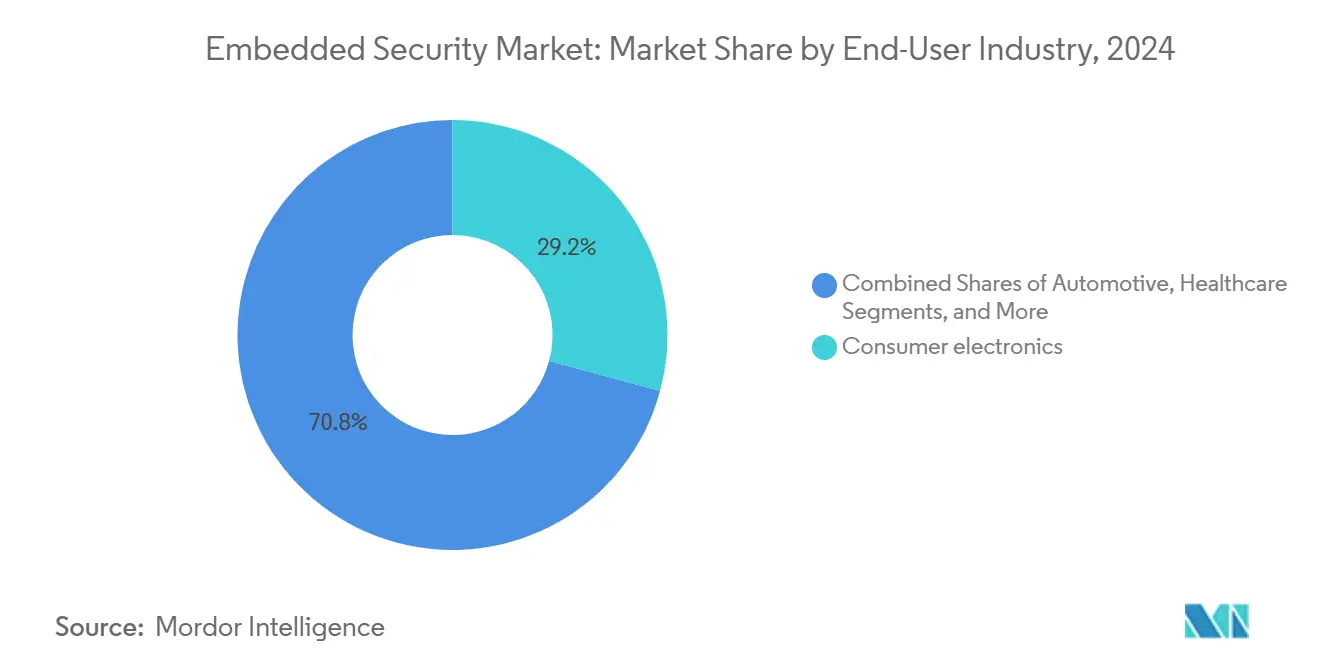
Note: Segment shares of all individual segments available upon report purchase
By Deployment Model: Cloud Environments Gain Momentum
By 2025, cloud-based deployments are poised to seize a robust 57% share of the market. This surge is driven by organizations migrating workloads to the cloud, seeking enhanced scalability and reduced infrastructure costs. Yet, while cloud deployments are on a rapid ascent, boasting a 13.22% CAGR, this growth underscores a pragmatic balance: organizations are weighing cloud advantages against the need for on-premises solutions for specific workloads. Such a balanced approach is especially pronounced in regulated sectors like healthcare, where data sovereignty and compliance often mandate a hybrid model.
On-premise deployments, while still vital in sectors with stringent security needs or those tethered to legacy systems, are witnessing a slow but steady decline in market share. This shift towards cloud and hybrid models is not just a trend but a response to the maturing landscape of cloud services and an escalating demand for flexible application deployment. Highlighting this momentum, Morgan Lewis notes a significant expansion in cloud services, bolstered by hefty AI investments driving performance gains. As organizations increasingly pivot to a cloud-first strategy for embedded security, it opens avenues for service providers adept in cloud migration and hybrid environment oversight.
Geography Analysis
Asia Pacific generated 37.8% of 2024 revenue, buoyed by its consumer-electronics manufacturing dominance and escalating smart-factory investments. National chip self-sufficiency programs in China, Japan, and South Korea promote local fabrication of secure elements, shortening supply chains and lowering import exposure. Regulatory attention to connected device safety now mirrors Europe’s caution, steering procurement toward certified hardware roots of trust. As a result, the embedded security market size within Asia Pacific is set to climb steadily, supported by factory automation retrofits and next-gen smartphone launches.
South America, although smaller, is projected to post a 13.3% CAGR thanks to large-scale automotive and 5G infrastructure build-outs. Stellantis’ USD 6.1 billion commitment through 2030 exemplifies how OEM capital inflows catalyze regional semiconductor ecosystems. Brazilian contract manufacturers are partnering with European IP vendors to deploy secure elements for flex-fuel hybrid powertrains, raising local content requirements that feed the embedded security market. Sovereign data-protection laws across the region add further impetus by mandating on-device encryption and lifecycle key management.
North America commands a robust share, underlined by leadership in post-quantum algorithm development and defense-grade secure architectures. Federal critical-infrastructure programs funnel grants into utilities and transportation networks, translating into volume orders for hardware-based key vaults. Europe’s landscape is reshaped by the Cyber Resilience Act, driving broad security-by-design adoption and harmonized certification frameworks that spur embedded security market expansion among consumer, medical, and industrial OEMs. Middle East and Africa, though currently modest, registers sustained growth through smart-city deployments and critical-asset protection initiatives across energy and transport corridors.
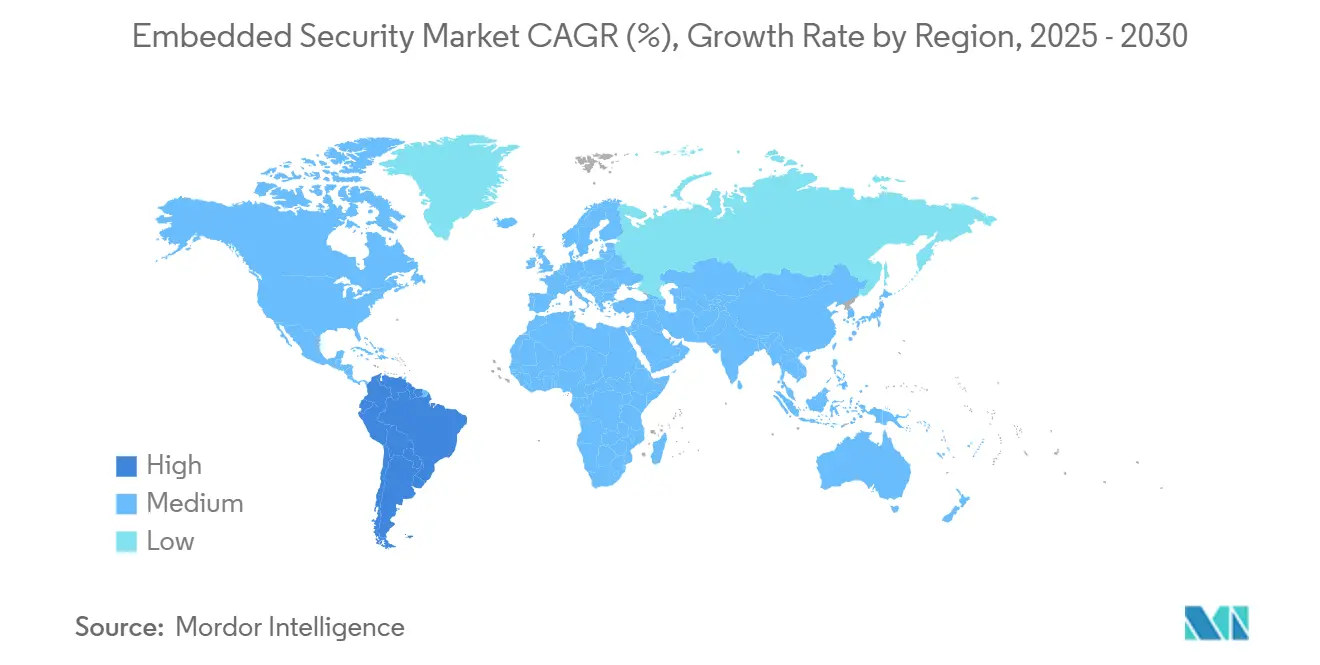
Competitive Landscape
Market concentration is moderate. Infineon Technologies, NXP Semiconductors, and STMicroelectronics remain leading suppliers of secure elements and microcontrollers that anchor enterprise, automotive, and industrial builds. Collectively, they hold a sizable share, yet leave room for mid-tier and niche players that innovate in power efficiency, post-quantum readiness, and auditable open architectures. Recent M&A has intensified solution breadth: Cadence acquired Secure-IC to fuse security IP blocks directly into EDA flows, enabling designers to harden SoCs early in the layout phase.
Chipmakers also forge vertical alliances; for example, Microchip collaborates with utilities on quantum-safe firmware signing, while STMicroelectronics partners with smart-meter OEMs to co-design secure boot sequences. White-space innovators, such as Tropic Square, gain recognition through transparent, open silicon that allows for independent inspection, a feature valued in defense and critical infrastructure. Concurrently, services firms like LevelBlue launch managed offerings that bundle PKI hosting, code-signing, and incident handling, broadening buyer choice beyond pure hardware.
Competitive edge now hinges on three factors: 1) the ability to deliver quantum-resilient silicon without power or cost penalties, 2) turnkey compliance toolchains that accelerate certification cycles, and 3) ecosystem depth, including secure provisioning, lifecycle analytics, and cloud-based key orchestration. Vendors meeting these criteria capture disproportionate growth as embedded security market requirements expand from device launch to end-of-life support.
Embedded Security Industry Leaders
-
Infineon Technologies AG
-
NXP Semiconductors NV
-
STMicroelectronics NV
-
Microchip Technology Inc.
-
Samsung Electronics Co. Ltd.
- *Disclaimer: Major Players sorted in no particular order
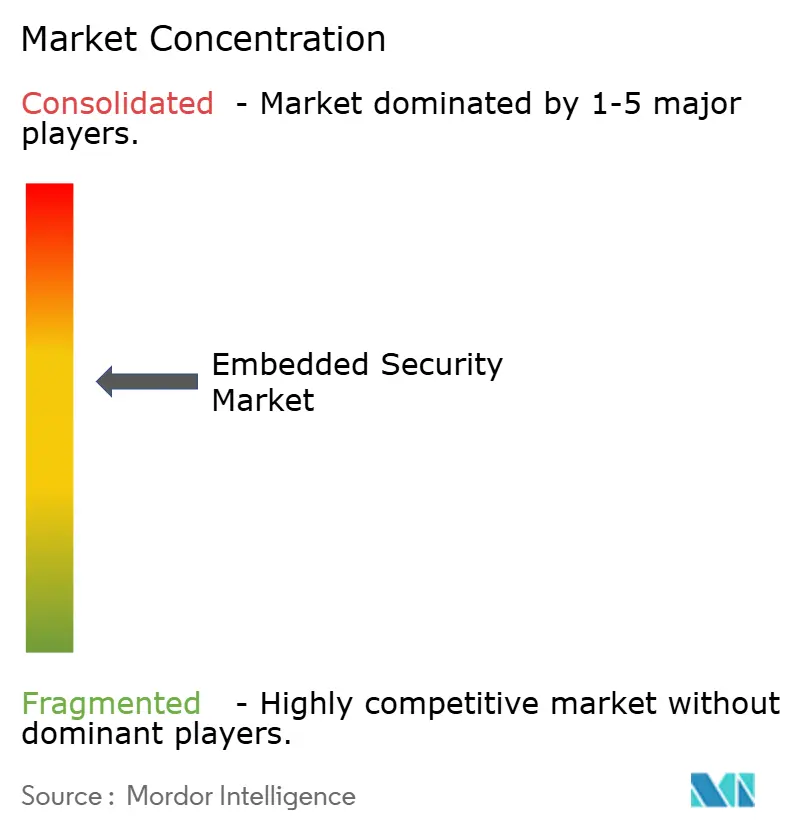
Recent Industry Developments
- May 2025: Microchip Technology introduced MEC175xB embedded controllers featuring hardware post-quantum cryptography, aligned with CNSA 2.0 standards.
- May 2025: Leidos acquired Kudu Dynamics for USD 300 million, extending AI-driven cyber capabilities for defense markets.
- April 2025: Keysight Technologies rolled out a next-generation embedded security testbench that automates vulnerability discovery before production release.
- March 2025: Stellantis committed EUR 5.6 billion (USD 6.1 billion) to South American operations, embedding security into Bio-Hybrid vehicle platforms.
- March 2025: Tropic Square won dual awards at Embedded World 2025 for its auditable TROPIC01 secure chip.
- March 2025: Infineon highlighted new microcontroller families optimized for embedded security during Embedded World 2025.
Research Methodology Framework and Report Scope
Market Definitions and Key Coverage
Our study defines the embedded security market as the global spend on hardware-anchored and companion software safeguards that are permanently built into microcontrollers, secure elements, trusted platform modules, or comparable silicon blocks, together with device-resident firmware that activates cryptographic, authentication, and secure-boot functions across connected products.
Scope Exclusions: Stand-alone network appliances, host-based antivirus suites, and purely cloud security services sit outside this definition.
Segmentation Overview
- By Component Type
- Hardware
- Software
- Services
- By Application
- Payment
- Authentication
- Content Protection
- Other Application
- By End-User Industry
- Automotive
- Healthcare
- Consumer Electronics
- Telecommunications
- Aerospace and Defence
- Other End-User Industry
- By Deployment
- On-premise
- Cloud
- By Geography
- North America
- United States
- Canada
- Mexico
- South America
- Brazil
- Argentina
- Rest of South America
- Europe
- Germany
- United Kingdom
- France
- Italy
- Spain
- Russia
- Rest of Europe
- Asia-Pacific
- China
- Japan
- India
- South Korea
- Australia
- Rest of Asia-Pacific
- Middle East and Africa
- Middle East
- Saudi Arabia
- United Arab Emirates
- Turkey
- Rest of Middle East
- Africa
- South Africa
- Rest of Africa
- Middle East
- North America
Detailed Research Methodology and Data Validation
Primary Research
Multiple discussions with chip vendors, tier-1 module suppliers, OEM firmware leads, compliance auditors, and regional regulators helped us verify use-case penetration, average selling prices, and regulation-driven replacement cycles across North America, Europe, Asia-Pacific, and Latin America. Insights from these interviews corrected early volume assumptions and clarified adoption lags in mid-tier consumer electronics.
Desk Research
We reviewed authoritative, open datasets such as NIST IR 8259A guidance, ETSI EN 303 645 baseline requirements, UN R155 automotive cyber rules, Eurostat customs flows for secure ICs, and ENISA threat-landscape notes, which are then matched with shipment series from WSTS, IDC handset trackers, and OICA vehicle production tallies. Our analysts further extracted company revenue splits and fabrication capacities from D&B Hoovers, plus patent intensity cues from Questel to map innovation hotspots. A similar scan of annual reports, FCC filings, and industry association white papers rounded out the secondary picture. The sources listed are illustrative; many additional references support data validation.
Market-Sizing & Forecasting
We built a top-down model that starts with annual secure-IC production, cross-border trade values, and connected-device stock, which are then segmented by application pools (payment, authentication, content protection). Select bottom-up checks, supplier roll-ups, and sampled ASP × unit pairings anchor reality inside acceptable error bands. Key variables include secure MCU unit shipments, average ASP erosion rates, IoT device install base, electric-vehicle production, and regulatory compliance deadlines. Multivariate regression links these drivers to historical market revenue before scenario curves (base, high-regulation, and cost-down) project 2025-2030 outcomes. Data gaps in emerging regions are bridged through prevalence ratios taken from comparable device classes.
Data Validation & Update Cycle
Modeled outputs pass three rounds of anomaly screening, peer review, and senior sign-off. Variances above predefined thresholds trigger a re-contact of select experts. Reports refresh each year, with mid-cycle tweaks when material events, such as chip bans or new cyber legislation, shift demand signals.
Why Our Embedded Security Baseline Commands Reliability
Published estimates often diverge because firms pick different component mixes, refresh cadences, and currency bases, which can inflate or suppress totals before the analyst even runs a forecast.
Key gap drivers include whether services revenue is bundled, how far down the supply chain device counts are sampled, the treatment of one-time programming fees, and in some studies, the omission of fast-growing Asia-Pacific volumes. Mordor analysts report 2025 as the anchor year and adjust every value to constant 2024 USD, while several peers use earlier baselines or wider cyber scopes that blur comparability.
Benchmark comparison
| Market Size | Anonymized source | Primary gap driver |
|---|---|---|
| USD 9.25 B (2025) | Mordor Intelligence | - |
| USD 10.20 B (2024) | Global Consultancy A | Bundles device-lifecycle services and secure-software royalties |
| USD 5.60 B (2024) | Trade Journal B | Excludes cloud-connected modules and uses limited geography |
| USD 7.40 B (2023) | Industry Association C | Older base year and slower refresh cadence |
Taken together, the comparison shows that Mordor Intelligence offers a balanced, up-to-date baseline tied to transparent variables and repeatable steps, giving decision-makers a dependable starting point for strategic planning.
Key Questions Answered in the Report
What is driving the current growth of the embedded security market?
Rapid IoT expansion, automotive cybersecurity mandates, and new regulations such as the EU Cyber Resilience Act are collectively pushing demand for hardware-rooted trust and lifecycle security services.
How large is the embedded security market size today?
The embedded security market size stands at USD 9.25 billion in 2025 and is projected to reach USD 15.06 billion by 2030.
Which component segment is growing fastest?
Services, covering audits, key management, and managed detection, are forecast to rise at 14.2% CAGR between 2025 and 2030 as firms outsource specialist skills.
Why is automotive the fastest-growing end-user industry?
Regulations such as UN R155, combined with electrification and ADAS complexity, require multilayered security architectures, pushing automotive demand to a 16.2% CAGR.
How will post-quantum cryptography influence embedded products?
Long-life devices in energy, transport, and defense already incorporate lattice-based algorithms; vendors that provide quantum-resilient silicon and agile key-rotation services will capture future market share.
What regions offer the highest growth potential?
South America leads in relative terms with a 13.3% CAGR through 2030, underpinned by automotive investment and 5G rollouts, while Asia Pacific remains the revenue leader.
Page last updated on:
